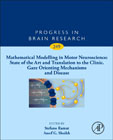
Mathematical Modelling in Motor Neuroscience: State of the Art and Translation to the Clinic. Gaze Orienting Mechanisms and Disease
Leigh, R. John
Ramat, Stefano
Shaikh, AASEF G.
Mathematical Modelling in Motor Neuroscience: State of the Art and Translation to the Clinic. Gaze Orienting Mechanisms and Disease, Volume 249, the latest release in the Progress in Brain Research series, highlights new advances in the field, with this new volume presenting interesting chapters on a variety of topics, including Mathematical modeling in clinical and basic motor neuroscience, The math of medicine - the computational lessons learned from the human disease, Mathematical models - an extension of the clinician's mind, From differential equation to linear control systems: the study of the VOR, Closed lop and nonlinear systems, State-space equations and learning, Integrators and optimal control, and much more. Provides the authority and expertise of leading contributors from an international board of authorsPresents the latest release in the Progress in Brain Research seriesIncludes the latest information on mathematical modeling in motor neuroscience INDICE: Section I -DIDACTIC: Modeling 1. Sequential Bayesian updating as a model for human perception Stefan Glasauer 2. Maps and sensorimotor transformations for eye-head gaze shifts: Role of the midbrain superior colliculus A. John van Opstal and Bahadir Kasap 3. Modeling gaze position-dependent opsoclonus Lance M. Optican, Janet C. Rucker, John-Ross Rizzo and Todd E. Hudson Section II - DIDACTIC: Translational 4. Eye position-dependent opsoclonus in mild traumatic brain injury John-Ross Rizzo, Todd H. Hudson, Alexandra J. Sequeira, Weiwei Dai, Yash Chaudhry, John Martone, David S. Zee, Lance M. Optican, Laura J. Balcer, Steven L. Galetta and Janet C. Rucker Section III - RESEARCH: Saccades 5. Saccades in Parkinson's disease: Hypometric, slow, and maladaptive Aasef G. Shaikh and Fatema F. Ghasia 6. Brainstem neural circuits for fixation and generation of saccadic eye movements Yoshikazu Shinoda, Mayu Takahashi and Yuriko Sugiuchi 7. Morphological and electrophysiological characteristics of the commissural system in the superior colliculi for conrol of eye movements Mayu Takahashi 8. Potassium channels in omnipause neurons Ümit S Mayadali, Karoline Lienbacher, Michael Mustari, Michael Strupp and Anja KE Horn 9. The cerebellum improves the precision of antisaccades by a latency-duration trade-off Pietro Piu, Elena Pretegiani, Francesca Rosini, Valeria Serchi, Domenica Zaino, Tommaso Chiantini and Alessandra Rufa 10. Saccade variability in healthy subjects and cerebellar patients Eggert T and Straube A 11. Electrical stimulation in a spiking neural network model of monkey superior colliculus A. John van Opstal and Bahadir Kasap Section IV - RESEARCH: Adaptation 12. A neuronal process for adaptive control of primate saccadic system Yoshiko Kojima 13. A unified computational framework for visual attention dynamics Dario Zanca, Marco Gori and Alessandra Rufa 14. Improving the repeatability of two-rate model parameter estimations by using autoencoder networks Ozdemir MC, Eggert T and Straube A Section V - RESEARCH: Nystagmus 15. Rebound nystagmus, a window into the oculomotor integrator Jorge Otero-Millan, Ayse I. Colpak, Amir Kheradmand and David S. Zee 16. Central positional nystagmus: Characteristics and model-based explanations Jeong-Yoon Choi and Ji-Soo Kim 17. Modulation of acquired monocular pendular nystagmus in multiple sclerosis: A modeling approach Ileok Jung, Sung-Hee Kim, Hyo-Jung Kim, Jeong-Yoon Choi and Ji-Soo Kim 18. Fixation instability in amblyopia: Oculomotor disease biomarkers predictive of treatment effectiveness M. Scaramuzzi, J. Murray, J. Otero-Millan, Paolo Nucci, A.G. Shaikh and F.F. Ghasia Section VI - RESEARCH: Dystonia 19. What can kinematic studies tell us about the mechanisms of dystonia? Anna Sadnicka, Joseph Galea and Mark J. Edwards 20. Implications of asymmetric neural activity patterns in the basal ganglia outflow in the integrative neural network model for cervical dystonia Alexey Sedov, Ulia Semenova, Svetlana Usova, Alexey Tomskiy, J. Douglas Crawford, H.A. Jinnah and Aasef G. Shaikh 21. A motor control model of task-specific dystonia and its rehabilitation Anna Sadnicka and Jaume Rosset-Llobet 22. Tremor in chronic inflammatory demyelinating polyneuropathy: Proof of unifying network model for dystonia Nataliya Pyatka, Alexey Sedov, Benjamin L. Walter, H.A. Jinnah and Aasef G. Shaikh Section VII - RESEARCH: Parkinson's disease 23. Oculomotor effects of medical and surgical treatments of Parkinson's disease Salil Patel, James J. Fitzgerald and Chrystalina A. Antoniades 24. Vestibular heading perception in Parkinson's disease Sinem Balta Beylergil, Sarah Ozinga, Mark F. Walker, Cameron McIntyre and Aasef G. Shaikh 25. A new approach for estimation of spiketrain patterns in basal ganglia Vladislav Myrov, Alexey Sedov, Alexey Tomskiy, Ludmila Myrova and Elena Belova Section VIII - RESEARCH: Others 26. A model-based study of internuclear ophthalmoparesis and ocular-motor fatigue in multiple sclerosis Jonathan B. Jacobs, Clara Chisari, Margaret M. Skelly, Mark F. Walker and Alessandro Serra 27. Central positional vertigo: A clinical-imaging study Emiliano De Schutter, Zachariah O. Adham and Jorge C. Kattah 28. Eye-hand re-coordination: A pilot investigation of gaze and reach biofeedback in chronic stroke John-Ross Rizzo, Mahya Beheshti, Azadeh Shafieesabet, James Fung, Maryam Hosseini, Janet C. Rucker, Lawrence H. Snyder and Todd E. Hudson 29. Kinematics and the neurophysiological study of visually-guided eye movements Laurent Goffart 30. Deficient head motor control in functional dizziness: Experimental evidence of central sensory-motor dysfunction in persistent physical symptoms Nadine Lehnen, Lena Schröder, Peter Henningsen, Stefan Glasauer and Cecilia Ramaioli
- ISBN: 978-0-444-64254-7
- Editorial: Academic Press
- Encuadernacion: Cartoné
- Páginas: 358
- Fecha Publicación: 01/09/2019
- Nº Volúmenes: 1
- Idioma: Inglés
